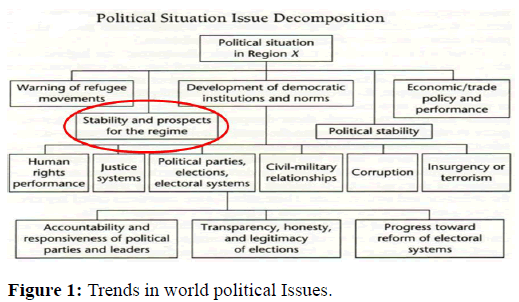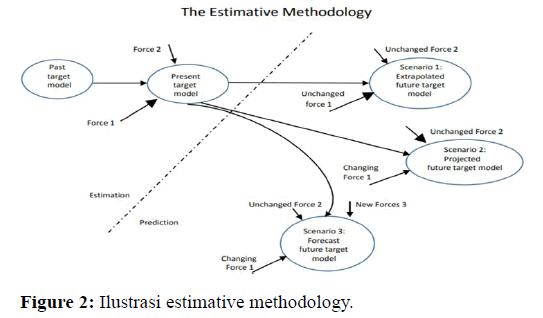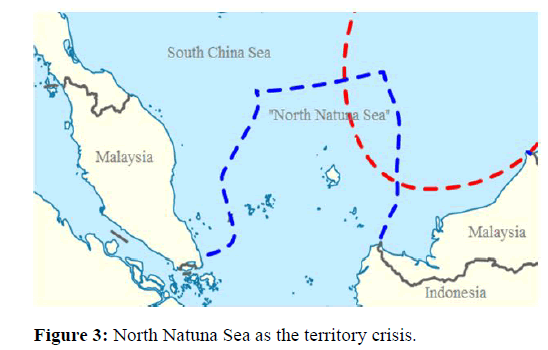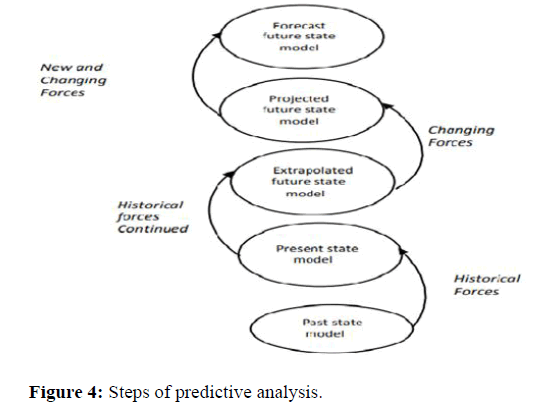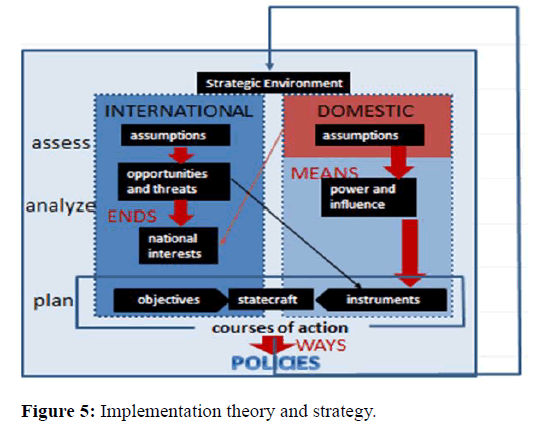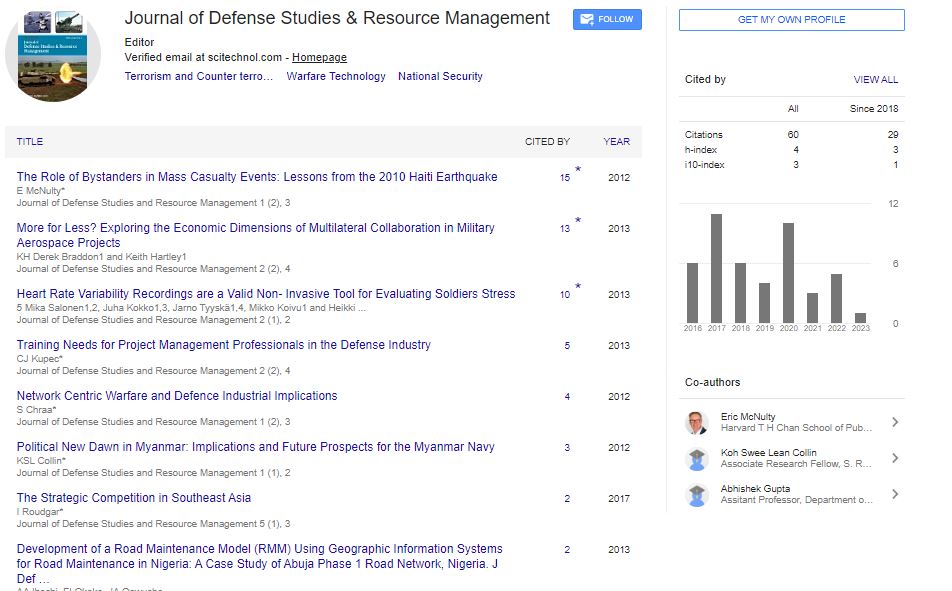Research Article, J Def Stud Resour Manage Vol: 11 Issue: 2
The Transformation of the North Natuna Sea Crisis in a Hybrid Warfare Scenario in the Southeast Asia Region between Arm Races and Alliance Defense Rivalry
Novky Asmoro* and Edy Sulistyadi
Department of Defense Management, Indonesia Defense University, West Java, Indonesia
*Corresponding Author: Novky Asmoro
Department of Defense Management,
Indonesia Defense University, West Java, Indonesia,
Tel: 817120716;
E-mail: novky.asmoro@idu.ac.id
Received date: 12 February, 2023, Manuscript No. JDSRM-23-89266;
Editor assigned date: 15 February, 2023, PreQC No. JDSRM-23-89266 (PQ);
Reviewed date: 01 March, 2023, QC No. JDSRM-23-89266;
Revised date: 13 April, 2023, Manuscript No. JDSRM-23-89266 (R);
Published date: 20 April, 2023, DOI: 10.4172/2324-9315.1000173
Citation:Asmoro N, Sulistyadi E (2023) The Transformation of the North Natuna Sea Crisis in a Hybrid Warfare Scenario in the Southeast Asia Region between Arm Races and Alliance Defense Rivalry. J Def Stud Resour Manage 11:2.
Abstract
The dispute that occurred in the North Natuna sea was triggered by overlap between claimant states where its territorial borders overlapped with another state. Even though the escalation of tension so far has never led to open armed conflict between the military forces of claimants and non- claimants states which have interests from within and outside the region, efforts to show mutual force and provocation appear to be getting bolder, and this will significantly affect the occurrence of stability disturbances of politics, economy and security in the Southeast Asian region. Using exploratory qualitative research methods and case studies, the use of data analysis using the miles-hubermann approach through data that has been validated between primary and secondary data, will produce a simulation of crisis projections going forward. The rivalry among the defense alliances that continues to occur has resulted in several scenarios of open conflict in Southeast Asia. As a conclusion as well as a starting point in promoting Asean's role in the midst of this crisis, Indonesia still has a strategic position in the region. The function of the dynamic equilibrium as a political position in the international arena makes Indonesia and its military forces very vulnerable to triggering potential arm races.
Keywords: North Natuna sea; Southeast Asia region; Defense alliance; Dynamic equalibrium and arm races
Introduction
The development of the crisis in the North Natuna Sea (NNS) is predicted to lead to an increasingly complex form of irregular warfare. These indications can be seen from the actors, tools, domains and phases or stages of the crisis [1]. In the irregular warfare projection, also known as hybrid warfare, a combination of military and nonmilitary methods is used in peacetime to achieve traditional military goals (e.g., control or territorial conquest), and thereby change the facts on the ground without triggering actual conflict. As stated by Michael Mazarr, from the national war college that peacetime hybrid warfare aims to achieve military goals, namely battlefield control [2]. This is clearly indicated when the increase in military strength and maneuvers of China and the United States, political statements of mutual claims by several countries and the development of the aggressiveness of defense alliances such as AUKUS, QUAD and FPDA have led to a hybrid war situation, namely winning military campaigns through the use of force in several levels of violence, or preparing for increasingly decisive military action [3].
The crisis at NNS has led to another transformation of the concept of hybrid warfare namely that this form of war combines conventional, asymmetrical war or threats and cyber warfare that is diverse and dynamic. In addition to these various combinations of threats, the potential for tension in Southeast Asia will be very vulnerable to the use of various weapons in the category of hybrid war tools, namely Chemical, Biological, Nuclear and Explosive Weapons (CBRNE), and information warfare [4]. Rivalry between the major powers of China and the United States simultaneously has pushed many countries, especially claimed states, to be dragged into the need and importance of forming a defense alliance. War scenarios that are complex with mixed interests will become the background for the conflict, it is unclear who the real perpetrators of war are, leading to the emergence of methods, methods, techniques and tactics of war which also lead to forms of hybrid warfare [5].
Indonesia's readiness, in this case the Indonesian Armed Forces (TNI), to face the NNS crisis will be related to how to organize a national defense system that is not only projected to face external enemies or actors, both state and non-state actors, but also in the form of the state and defense alliance forces [6]. Furthermore, if the crisis scenario at the NNS continues to develop, it is very possible that the hybrid warfare at the NNS will have implications for the problem such as terrorism, insurgency and cyber warfare in Indonesia. Therefore, the procurement of TNI weapons also needs to be projected and prepared for the possibility of facing those problems [7].
Materials and Methods
In order to predict the transformation and trend of hybrid threats in the NNS crisis, it is necessary to play the role of intelligence analysis which will comprehensively predict the impact and relevance in the future so that a military doctrine that is more adaptive is needed to be prepared (Figure 1). The intelligence analysis process requires a special method known as the estimative methodology where the predictive analysis presented regardless of the configuration will be able to accurately predict several key variables to be presented through several levels of analysis to the customer as material for decision making [8].
To conduct a predictive analysis of the potential for hybrid warfare in the escalation of the NNS is important because of the potential implications of its form such as cyber warfare, insurgency and terrorism including several problems of world strategic political issues trends which will also color tensions in the Southeast Asian region [9]. The Figure 1 describes that arm races and competition between defense alliances as part of hybrid warfare are included in strategic intelligence issues whose data continues to be explored, especially in the category "stability and prospects of the regime". This is relevant to the development of the main characteristics of the role of modern intelligence, namely;
• Analysis on any subject is a continuous process. Customers
increasingly need intelligence support every day regarding a number
of problems, both general and specific.
• Analysis can take many forms by utilizing many sources in an effort
to obtain more complete data and information. Several sources
include special expertise from the academic realm, social media, or
industry.
Estimative methodology
Predictions in an intelligence product are crucial things needed by decision makers. Through the use of estimative methodology, various predictive analysis processes are carried out in order to obtain high validity and reliability of information so as to achieve a reliable level of analysis so that predictions about the future condition of an intelligence object can be estimated. Different estimation methods are used under different conditions [10,11]. Several models of estimative methodology, one of which is applied to military intelligence through the process of predictive analysis, include:
Extrapolation models: This prediction method is the most conservative method and suitable for short term estimation. In its simplest form, extrapolation, using historical performance as a basis, to indicate future directions [12]. (Determining the variables of the estimated object that is extrapolated to the future without changing the variable).
Projection models: In this model, it is done by predicting various future possibilities based on the assumption that the forces that have been in effect in the past will change, while extrapolation assumes that the forces do not change (determine one variable that is considered the most dominant or most influential in the future).
Model forecasting: The predictive model in this intelligence activity is to determine alternative futures of targets, not just the most likely future. But being able to formulate long term alternatives and scenarios that are most likely to occur in the future (determining new variables outside of existing variables but still having relevance to them).
Of the three forecasting models that lead to the emergence of new variables when forecasting is carried out, the next step is to determine which of all these variables has the greatest effect but the probability of occurrence is low (high impact low probability). The result of this High Impact Low Probability (HILP) is a demonstration scenario and the process for determining HILP is carried out through the following stages (Figure 2) [13].
• Determine the variable that is considered to have the most
significant impact outcome because this will be analyzed
continuously.
• Compile a logical analysis description of the variables or forces that
are expected to have the lowest impact. This is important in
determining the indicators that need to be monitored during the
predictive analysis process.
• Determine the most significant factor that can trigger sudden and
comprehensive changes to the object of analysis.
• Carry out a brainstorming process related to the breadth of
experience of each intelligence agent in an effort to find the
strengths or variables that are most likely to occur, are unpredictable
but can suddenly change the entire analysis result.
• Always carry out monitoring of the indicators that have been
determined to prevent them from deviating from the analysis path.
• Identify all estimated factors that will either bring good or bad
outcomes.
Determining an estimate for global conditions in the future can be done by studying the strategic environment in the military, political, economic and social fields which tends to change rapidly. These problems have component strengths that can be identified using a variant of the strategy methodology [14]. Forecast changes in these forces are analyzed through trends and the resulting events later between one event/trend are linked together through techniques such as cross-impact analysis. The result is a forecast of the most probable future that is made in a scenario format. If the forecasts made work properly, this will encourage policy makers to make decisions and for the intelligence world, will result in action in response to real and intangible threats.
In order to get valid and reliable prediction results, several processes are carried out in it including brainstorming. This step is very important in determining the six main questions for the object of estimation or called the six pointed star which includes who, what, when, where, why and how. Besides that, through the brainstorming stage, it will be possible to determine the key assumption check stage which is a hypothesis that has been declared correct and is part of the problem definition or as a product of the final assessment [15].
Results and Discussion
In relation to the crisis at the NNS, the existence of arm races and the rivalry between defense alliances and the potential for the emergence of hybrid threats can be understood as the complexity of the potential combination of military and non-military threats. This phenomenon has occurred in peacetime like today to achieve the goal of the threat in the form of the results of traditional military wars in the form of territorial control or conquest. It becomes something that is interesting to discuss when the potential for a hybrid war scenario to develop as a result of the NNS crisis escalating, let alone causing an open war. Therefore, faced with the doctrine of modern warfare and a dynamic threat spectrum, it is necessary to anticipate the occurrence of a regional crisis transformation with the strategic goals of the actors, one of which is the ability to face threats/hybrid war.
The dispute that occurred in the NNS was based on overlap between claimant countries where one country's territorial borders overlapped with other countries. For example: The Chinese foreign minister in 2011 could not accept the Philippines' claim to the sovereignty of several islands in the NNS. China claimed in 2015 that from the perspective of history, geography or international law, the Nansha (Spratly) Islands, Shisha Islands (Paracel), Chungsha Islands (Macclesfield Bank), and Tungsha (Pratas) Islands, as well as their adjacent waters, constitute a unified entity inherent in the territory and waters of the China. The government of People Republic of China (PRC) retains all rights to the islands in accordance with international law. The following examples of claims were made by Vietnam, the Philippines, Malaysia and Brunei Darussalam and again with China regarding international law disputes (Figure 3). The countries involved in the dispute have their own perceptions regarding the legality of ownership of the area over the sea.
The situation is getting more complex when China faces the US in securing its energy security interests, by trying to control water areas that were previously acceptable in a compromise manner through diplomatic either official or unofficial channels. Even though the escalation so far has never led to open armed conflict between the military forces of claimants and non-claimants which have interests from within and outside the region, efforts to show mutual strength and provocation appear to be getting bolder. This will significantly affect political, economic and security stability in the Southeast Asian region. According to Figure 3, that illustrates the rising of military exercises, maneuvers to violate territorial waters in the Indonesian exclusive economic zone and China's Nine Dash line claims to the development of armed forces and military facilities are strong indications that the potential for open war will threaten political and security stability which will lead to economic instability in the region.
China's response has also strengthened in its aggressiveness to establish dominance in the NNS with indications of an increase in China's 2019 defense budget data at 1.19 trillion Yuan, an increase of 7.5% from the previous year, 2020: 1.27 trillion yuan (US$ 178 billion), an increase of 6.6% and in 2021: 1.35 trillion yuan (US$ 209 billion), an increase of 6.8%. While the Chinese government purchases and own products in the form of major imports: 300+Sukhoi fighter jets, 12 Kilo-class submarines, 4 Sovremenny-class missile cruisers, and around 1,000 surface to air missile batteries (SAM/ Surface to Air Missile) S-300 to strength titles in NNS including 900 SRBM/short range ballistic missile (range 1000 km), SAM S-300 system, sunburn, and sizzler ASM/Air-to-Surface Missile is concrete evidence if an increase in military power occurs between countries that have an interest in the region.
The various phenomena above certainly bring their own complexity with the potential for open conflict that originates from various forms of threats. To deal with hybrid warfare scenarios that originate from regional crises need to be based on a doctrine that can be adaptive to the mission objectives to be achieved, including overcoming hybrid wars. In the future, there will be a need for a capability to deal with hybrid warfare scenarios that can accommodate the way of acting in military operations to be deployed when facing threats in the hybrid threat category. Therefore, it is necessary to try or implement predictive analysis to determine the future scenarios for facing hybrid machetes based on several variables that will be determined next.
In carrying out predictive analysis, it is necessary to carry out several stages which will later be processed through several predictive analysis models, extrapolation, projection and forecasting. Steps taken include:
• Determining a condition from a pattern whose existence can be
predicted based on past conditions to the future. The pattern that is
focused here is the hybrid war facing scenario.
• Determine the forces or several factors that influence the existence
of a pattern in facing of hybrid warfare scenario. The forces or
factors that influence it are the threat spectrum, dynamics of the
strategic environment, and tradition or history. These three factors
will be used as variables that are fixed/will not change in the future
even though their values will increase or decrease as extrapolation
models.
• For these three forces or factors, one factor is determined which is
predicted to have the most dominant influence or experience the
highest dynamics. This will later be used predictive analysis with
the Projection model, in this case, the threat spectrum (Table 1).
| Variable/model of predictive analysis | Extrapolation | Projection | Forecasting |
|---|---|---|---|
| Threat spectrum | Steady | Dominant | None |
| Strategic environment | Steady | Steady | None |
| History | Steady | Steady | None |
| Facing scenario of hybrid warfare | None | None | Dominant (HILP) |
Table 1: Matrix of hybrid war scenario variable vs. model predictive analysis.
• Starting from the extrapolation and projection model, a new force or
factor is determined which is predicted to emerge as a new force
that can occur or directly impact the facing hybrid war scenario
pattern and this model is referred to as the forecast model. The
forces that are estimated to emerge are the new war strategy. The
relationship between variables and the predictive model of analysis
can be seen in matrix at Figure 4.
• Determine predictions from the future conditions of the hybrid war
facing scenario as a pattern or target model based on the assessment
of each strength. They will be measured or weighed by weight.
Dominant strength will be measured in this prediction through
several estimation tools including regression and Monte Carlo
simulation.
Based on the results of the predictive analysis above, it is found that of the three fixed variables used for extrapolation one dominant variable will be obtained, namely the threat spectrum as the projection result. This indicates that the scenario of facing a hybrid war in the future must be adaptive to the dynamics of threats that occur. So it is right if the potential threat of hybrid war needs to be predicted in the future so that the doctrine prepared is in accordance with the needs of military operations.
Specifically, prediction results are also obtained by forecasting that the hybrid war facing scenario turns out to be a new variable that appears and is in accordance with the rules of predictive analysis, so this is an indication that for the future the war strategy will continue to transform even though the possibility is small but the effect is very large (high impact low probability). This situation is very relevant because the battle strategy if it is predicted will not change much from the classical theory of strategy which states that “a coherent expression of a process that identifies the ends, ways, and means designed to achieve a certain goal. Mathematically, we might express this as “strategy=ends+ways+means.” Ends are the objectives or desired outcomes of a given strategy. The term end state is synonymous with ends. An end or ends comprise the goal of the strategy. Ways are actions” (Figure 5).
The next step after successfully determining a new variable from the forecasting model which is a variable with a high impact low probability character is to design a demonstration scenario. Scenarios, which are products of high impact low probability analysis, can be generated if an intelligence analyst is able to identify high impact outcomes and then determine a logical way to achieve them. There are several ways to get a high impact outcome, one of which is by using an alternative version of the demonstration scenario, namely the branch point scenario.
The main function of the demonstration scenario is to pay more attention to the results of the analysis of the branch point scenario than to the final result of the analysis. So the new hybrid war facing scenario as HILP, for an intelligence analyst will not focus on that scenario, but instead on how to realize the scenario of facing the new hybrid war because it has the most impact even though it is unlikely that it will happen in the future. The stages in getting the best scenario in determining the best scenario facing hybrid war generally follow the following phases, namely;
• Defining the problem this leads to the “what question will the
encountering hybrid war scenario actually answer?”
• Identify what factors will influence the development of a hybrid
warfare scenario. In this phase, intelligence analysis will determine
the main factors and priorities in the preparation of hybrid warfare
scenarios.
• Identify the most feasible solution to implement in principle, there
are several more scenarios in it, namely: Emergency scenario
(created by positioning the intelligence analyst as an opponent), what-if scenario is not limited (unconstrained) and what-if scenario
is limited (constrained).
• Looking for the best solution in realizing the best hybrid warfare
scenario. This can be followed by designing a simulation of the new
war strategy as a result of forecasting the facing scenario of hybrid
warfare.
You can imagine how complex it is to formulate a doctrine and scenario in dealing with a hybrid war due to the diversity of actors, domains, phases and tools. Countries in the region with varying levels of independence in relation to their military strength, logically will be carried away by the conditions mentioned in the arms race model theory, namely that there will be a reflection of a nation's fear of the state of other nations' weapons. This feeling of mutual fear encourages a nation to increase weapons in order to maintain security comparable to that of the opposing nation.
As China is building its military bases at NNS, this is a form of a security dilemma on the basis of defending its territory. The response was given by other claimed states such as Vietnam, Malaysia, the Philippines and Brunei which needed to ensure that the building of military power did not trigger a domino effect in the form of arms competition between countries which could trigger an escalation of conflict to an open conflict stage which would make the situation even less conducive.
Besides that, the crisis in the region related to the NNS's mutual claims involving many countries will certainly involve other countries or defense alliances such as the Aukus, Fpda, QUAD and Indopacific. The existence of this alliance has an interest in controlling large economic resources in NNS and it is an integral part of the regional dynamics of Asia Pacific and Southeast Asia so it is needed in the effort to balance of power in the region from the hegemony of major powers. This is a concrete indication if threats with an economic dimension begin to strengthen as the main motive for the crisis at NNS. Forecasting about the need for scenarios facing hybrid wars with economic motives can be an important starting point if a country wants to dominate other countries.
China's foreign policy implications have created anxiety and a crisis of confidence in NNS and beyond. China's inflexibility regarding its interests in the region and territorial disputes, and including NNS in China's list of core interests, prompted US intervention in NNS. The relatively strong military power of other claimed states gives China a more advantageous position compared to countries in other regions and provides space for it to play its role as a balance of power in the region. Countries in the region also responded by increasing their military capabilities and this situation brought them closer to the US. Efforts to get involved more seriously in the midst of NNS tensions, indicated by the policy of the US department of defense which sets three goals for US maritime interests in the NNS region, namely maintaining freedom at sea; prevent conflict and coercion and promote compliance with international law and standards.
The US political policy is strengthened by its move to urge all parties to seek peaceful ways of resolving their disputes, which include diplomacy and dispute resolution involving third parties, such as filing arbitration claims by the Philippines in accordance with the dispute resolution procedures in the law of the sea convention. In this section, it has also begun to appear that the US has launched an "threat to international legislation". This could become a new domain of hybrid warfare in modern times where only a country with strong military and political power will be able to win it while strengthening its influence for other countries or alliances.
Principally, various efforts to involve the US in the region in controlling the NNS are to protect its allies in the event of a conflict with China, prevent China's domination of the NNS, secure freedom of navigation unilaterally, and maintain the proper position and statusquo in the Asia-Pacific region by maintaining peace and stability. At NNS in this case, it is clear that the US is only limiting its role in partnering ASEAN countries to a limited extent, such as holding joint military exercises and using proxy strategies through ASEAN countries such as Indonesia, Malaysia, Singapore and the Philippines.
Indonesia clearly places the potential for conflict in the NNS as a reason for building military strength as evidenced by the construction of an integrated TNI base and several joint military exercises around Natuna Island. The threat from NNS has even been projected by the government as the main trouble spot and prediction of the direction of the main threat to Indonesia. After the construction of a military base and its supporting facilities, the government's next program is to form an integrated TNI unit and a joint regional defense command. The purpose of forming this integrated TNI unit is aimed at providing deterrence against every threat in the Natuna region. The development of an integrated TNI unit will develop into a permanent and integrated organization under one command and equipped with an operational control system based on network centric warfare. The Indonesian government has four principal dimensions of interest in shaping NNS policies, namely,
• Sovereignty and resources.
• Military and security.
• Indonesia-China bilateral relations.
• ASEAN centrality and cohesion.
Strategically, the development of this military power can be interpreted as an effort to play Indonesia's role as a dynamic equilibrium in Southeast Asia because as the main country in Asean it has relatively good bilateral relations with the US and China, especially in the context of the conflict in the NNS. Through this role, Indonesia seeks to encourage the implementation of the code of conduct at NNS by prioritizing problem solving with peaceful Asean diplomacy instruments without using force and violence in order to create comprehensive regional security.
Conclusion
There needs to be commitment among Southeast Asian countries based on the centrality of ASEAN in the successful resolution of the NNS problem which was initiated starting from the Manila declaration' in July 1992 and the preparation of the 'code of conduct' for NNS in March 1995, the declaration on the conduct of parties in the South China Sea' (DOC) ASEAN and China in November 2002, the "guidelines to implement the DOC" agreement in July 2011 and the agreement on the formulation of the code of conduct' in November 2012 although this was not easily accepted by China where Chinese diplomats considered that the ASEAN and China meetings At that time, China was not the right place to discuss the NSS issues.
The conflicting parties need to prioritize the settlement of territorial and jurisdictional disputes in a peaceful way, without using threats or using force, through friendly consultations and negotiations. The parties need to agree to refrain from engaging in activities that will consequently complicate or increase disputes through cooperative activities. The parties must be prepared to continue consultation and dialogue on relevant issues, through the modalities to be agreed upon including adherence to this declaration in order to achieve the goals of promoting harmonious neighborly living and transparency, building harmony, mutual understanding and cooperation, and facilitating peaceful settlement of disputes.
References
- Scobell A, McMahon M, Cooper III CA (2015) China’s aircraft carrier program: Drivers, developments, implications. Nav War Coll Rev 68:64-79.
- Noesselt N (2021) China’s new regional responsiveness: Passive agency and counter agency in processes of democratic transitions in Asia. Democratization 28:219-236.
- Garcia SM, Rosenberg AA (2010) Food security and marine capture fisheries: Characteristics, trends, drivers and future perspectives. Philos Trans R Soc Lond B Biol Sci 365:2869-2880.
[Crossref] [Google Scholar] [PubMed]
- Dawdy SL (2011) Why pirates are back. Annu Rev Law Soc Sci 7:361-385.
- Ashton PS, Morley RJ, Heckenhauer J, Prasad V (2021) The magnificent dipterocarps: Precis for an Epitaph?. Kew Bull 76:87-125.
- Doshi TK, Zahur NB (2021) Singapore’s energy sustainability policies: Balance between market and government. Sustain Environ Decis Making 311-375.
- Schroefl J, Kaufman SJ (2014) Hybrid actors, tactical variety: Rethinking asymmetric and hybrid war. Stud Confl Terror 37:862-880.
- Angstrom J (2017) Escalation, emulation, and the failure of hybrid warfare in Afghanistan. Stud. Confl Terror 40:838-856.
- Bachmann SD, Papithi A (2016) Russia’s hybrid war and its implications for defence and security in the United Kingdom. Sci Mil: South African J Mil Stud 44:28-67.
- Cioculescu SF (2016) Perceptions of changing power, dyadic rivalries and security dilemma mechanisms in the wider Black Sea area. Stud Polit Rom Political Sci Rev 16:377-407.
- Hamayotsu K (2002) Islam and nation building in Southeast Asia: Malaysia and Indonesia in comparative perspective. Pacific Aff 353-375.
- Paul TV (2022) Realism, liberalism and regional order in East Asia: Toward a hybrid approach. The Pacific Rev 35:1028-1048.
- Seymour LJ (2014) Why factions switch sides in civil wars: Rivalry, patronage, and realignment in Sudan. Int Secur 39:92-131.
- Evans M (2011) Power and paradox: Asian geopolitics and Sino-American relations in the 21st century. Orbis 55:85-113.
- Atland K, Kabanenko I (2020) Russia and its Western neighbours: A comparative study of the security situation in the Black, Baltic and Barents Sea regions. Eur Asia Stud 72:286-313.
 Spanish
Spanish  Chinese
Chinese  Russian
Russian  German
German  French
French  Japanese
Japanese  Portuguese
Portuguese  Hindi
Hindi 